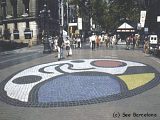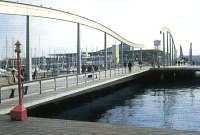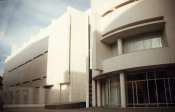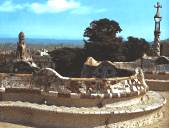|
Deze pagina is verplaatst naar: www.zibkip.be...... This page has moved to: www.zibkip.be...... |
![]()
![]()
A r e a s |
La Rambla | Waterfront | Barrio G˛tic and Ribera | El Raval | El Eixample | Gracia | Montju´c |Areas printable page
About Barcelona
Barcelona is a varied, lively, modern and very beautiful city. It doesn't matter if you're interested in modern or classical arts, contemporary architecture or historic buildings, small museums or big, there is something to see for everyone. To host the Olympic games of '92, brand-new neighborhoods were designed, new museums were built, streets were renovated, in short, the city got a completely new and very attractive appearance. Limited City map.
Las Rambla
 This is the most famous street in Barcelona. The Ramblas exists of several parts,
beginning at Plaša de Catalunya, and ending 1,5 km (+- 1 mile) further at the harbor.
Plaša de Catalunya is a nice green and lively plaza in the middle of the
city center, with several bus stops and underneath an important metro and train station.
El Corte InglŔs, the impressive grey building is the oldest department store in the city.
The tourist information center also has an office at Pl. de Catalunya n░17 s ( 9am -
9pm). Really everyone walks on the Ramblas: businessmen getting to their jobs, housewives
with shopping bags, strollers who want to see and be seen, and lots of tourists. Walking
under the trees is a nice experience, even if you're not interested in the flower stands,
bookstands, birdcages or the various street artists. The walk from one end to the other
can take you 30 minutes or even hours, just as you like. Next to the pedestrian boulevard
is traffic rushing by, and at both sides of the street there are lots of shops, hotels and
restaurants. This is the most famous street in Barcelona. The Ramblas exists of several parts,
beginning at Plaša de Catalunya, and ending 1,5 km (+- 1 mile) further at the harbor.
Plaša de Catalunya is a nice green and lively plaza in the middle of the
city center, with several bus stops and underneath an important metro and train station.
El Corte InglŔs, the impressive grey building is the oldest department store in the city.
The tourist information center also has an office at Pl. de Catalunya n░17 s ( 9am -
9pm). Really everyone walks on the Ramblas: businessmen getting to their jobs, housewives
with shopping bags, strollers who want to see and be seen, and lots of tourists. Walking
under the trees is a nice experience, even if you're not interested in the flower stands,
bookstands, birdcages or the various street artists. The walk from one end to the other
can take you 30 minutes or even hours, just as you like. Next to the pedestrian boulevard
is traffic rushing by, and at both sides of the street there are lots of shops, hotels and
restaurants. The Ramblas exists of five parts starting at Plaša de Catalunya: Rambla de Calanetes, Rambla del Estudis, Rambla St. Josep - also called Rambla del flors because of the flower stands -, Rambla del Capuxtins and Rambla de Santa Monica. There are lots of places of interest on and near La Rambla, I'll describe them in order coming from Pl. de Catalunya. Rambla Map (90 kb). The third street on the left side is Carrer
Portaferissa, a shopping street. More details on shopping page. This street leads into the Barrio
Gotic and Ribera, the oldest districts. |
| At the end of the Rambla, the monument of
Christopher Columbus is overlooking the city. Columbus on top of the column
was meant to show the way to the 'New World', but by mistake he is pointing in the wrong
direction, he points at Malaga. You can get to the top of the statue by elevator, for a
view of the Ramblas and the harbor. If you
walk further to the harbor, you'll get to the completely renovated waterfront. |
| This area exists of different parts at the
seaside. These areas have been changed the most before the Olympic games. Just cross the
street at the Columbus statue and you'll bump into the waterfront. |
 |
Right in front of you, you'll see the beautiful
wooden bridge connecting the mainland with Moll d'Espanya and the marina
Port Vell. At Moll d'Espanya there is the shopping mall Maremagnum with a gigantic mirror
wall in which the water reflects beautifully. Also at Moll d'Espanya you'll find an IMAX
theatre and an aquarium with displays on flora and fauna of the Mediterranean sea. |
| At the left of Columbus you'll see the promenade
Moll de la Fusta with funny red bridges, palm trees, bars and restaurants. At the
end of the promenade stands Cap de Barcelona, a colorful sculpture made by Roy
Lichtenstein. At this point you can start your walk to Barceloneta, passing the nice
promenade around Museu d'historia de Catalunya leading to the Olympic village. Barceloneta is a typical, old fishing neighborhood which has been cleaned up within the scope of the Olympic games. It is still very picturesque with his narrow streets, small old bars and laundry hanging out to dry between the balconies full of flowers. If you have the time, just stroll through the small streets, there is nothing spectacular to see, but it is nice. Following the shoreline you'll pass some beaches, they look nice, but I don't know if the water is clean enough to swim in. In the distance you can see the buildings of the Olympic village. It takes quite a walk from the Rambla to the Olympic village, but it is a pleasant one. |
 Barri(o)
G˛tic and Ribera are different areas but because they are adjacent and both are
part of the old city (Ciutat Vella), I've put them together. Barri(o)
G˛tic and Ribera are different areas but because they are adjacent and both are
part of the old city (Ciutat Vella), I've put them together.The Gothic area borders the left of the Rambla, Ribera lays a bit more eastwards. It are classical areas, you 'll find it interesting here if you like the architecture and the atmosphere of before the 20th century. Especially the gothic area is crowded with tourists, I find Ribera more pleasant. The Barrio G˛tic is full of history, there are still parts of a 2300 year old Roman wall, lots of old palaces and plazas. Centrally located is the Gothic cathedral, which was started building in the 14th century, and the fašade only being finished in the 19th century. The City hall is on Plaša Jaume I. Ribera is separated from the Barrio G˛tic
by the avenue Via Laietana. Some more gothic buildings can be found here. Carrer Montcada
is an important alley with art galleries, palaces and restaurants. Important is the Picasso
museum at n░15, with a collection showing the evolution of the artist beginning
at his early works. |
This is a student area and there is some
interesting contemporary architecture and museums to see. The area starts at the
University, Plaša d' Universidad . At Montalegre n░ 5 is the Centre
de Cultura Contemporani located. Worth a look for the square in the middle of the
buildings, with a mirror wall, surprisingly reflecting the harbor, a few hundred meters
from here. Closed on Monday. . At Montalegre n░ 5 is the Centre
de Cultura Contemporani located. Worth a look for the square in the middle of the
buildings, with a mirror wall, surprisingly reflecting the harbor, a few hundred meters
from here. Closed on Monday. If you're at the back of this building, you'll see two great contemporary buildings. One of them is the MACBA (photo); Museu d'Art Contemporani de Barcelona (museum of contemporary art) at Plaša Angels n░ 1. There is a nice museum store (temporarily closed in 2005). Closed on Monday, open Tuesday - Friday 12 a.m. - 8 p.m., Saturday 10 a.m. - 8 p.m., Sunday and holidays 10 a.m. - 3 p.m.. MACBA has a website. I'm not sure what the other building is. |
Introduction
| During the half of the 20th century there was an
increase of population and the city became too small. Architect I. Cerda was appointed to
design new areas to host workers but he had to work especially on accommodation for the
middle class. His plans were changed completely, the planned parks were deleted and the
only thing that was kept, was the chessboard pattern of the streets. However, El Eixample
is still an area with great importance in architectural way. It is more like an open air
museum, where some of the most striking Modernist buildings are displayed. It is in many
ways a very pleasant area, almost in every street you will discover beautiful houses, and
the main streets are filled with elegant shops. More information about Modernism and the important architects of this period on the architecture page. Rambla
de Catalunya is a a continuation of the other Rambla, but it is completely
different, because it had to become the promenade for the rich. Expensive shops and some
beautiful houses are located here, especially the Modernist fašades of n░ 21 to 27 are
worth to look at. If you walk on this street you'll see in a street on the right, Carrer
d’ Arago, the spectacular steel wire work of art of Antoni Tapies on the roof of Fundacio
Tapies, a gallery with works of the Spanish painter and other contemporary
artists.
Next to Casa Battlˇ on n░41 is Casa Amattler, a Neogothic building of architect Puig i Cadafalch. The headquarters of Tourist information at n░35 is located in another important building, Casa Lleˇ Morera by DomŔnech i Montaner. On Carrer Mallorca there are more buildings
designed by DomŔnech i Montaner, like Palau Montaner (on the corner of Carrer R. de
Lluria)and Casa Thomas at n░ 291.
|
The district of Gracia is not very well known
among tourists and there isn't really anything spectacular to see, but it is a
pleasant residential area, nice to stroll trough when you visit Parc GŘell which is not far from here.
Parc GŘell is another wonderful Gaudi project. The park was designed to become a
residential area for the rich, but the project was canceled because there weren't enough
investors and because World war 1 broke out, the building stopped at three houses, in one
of which Gaudi lived during the building. Casa GaudÝ , displaying some
of his furniture and works can be visited. At the entrance of the park are an office and
porter's lodge with a mosaic tower, and the Dragonfountain. Eye-catcher is the long mosaic
coilbench, forming the border of a plaza, supported by 100 pillars : the Greek pillarhall.
The park is big, but the most important stuff is not far from the entrance. Standing on
the plaza you have a beautiful view over the city. spectacular to see, but it is a
pleasant residential area, nice to stroll trough when you visit Parc GŘell which is not far from here.
Parc GŘell is another wonderful Gaudi project. The park was designed to become a
residential area for the rich, but the project was canceled because there weren't enough
investors and because World war 1 broke out, the building stopped at three houses, in one
of which Gaudi lived during the building. Casa GaudÝ , displaying some
of his furniture and works can be visited. At the entrance of the park are an office and
porter's lodge with a mosaic tower, and the Dragonfountain. Eye-catcher is the long mosaic
coilbench, forming the border of a plaza, supported by 100 pillars : the Greek pillarhall.
The park is big, but the most important stuff is not far from the entrance. Standing on
the plaza you have a beautiful view over the city.Bus 24, 25, 31, 32, 74 or metro line 3, stop Lesseps, but then you have a good walk uphill ahead. At Lesseps you can take the mini bus 116 to the park. |
Montju´c
| The mountain Montju´c is the green area of the
city. Because of the world fair in 1929 parks, palaces, pavilions, sports stadiums and
exhibition halls were built. Some of those buildings remained and house some important
museums or were renovated to accommodate sports activities during the Olympic games of
1992. I'll start my summary at the foot of the mountain.
Plaša d'Espanya is nearby, and is with his two towers and fountain the entrance gate to Montju´c. The fountain is colorfully lit at night. Standing here gives you a view of the stairs to the mountain, with on top the Palau Nacional, housing the Museu d'Art Catalunya (Medieval art).
The futuristic sports palace Palau
d'esports San Jordi,(photo left) was designed for the games in '92 by the
Japanese architect Isozaki and can seat up to 15.000 people. The plaza in front of
the building offers a great view; on the left the Olympic stadium with in front water
terraces, at the entrance of the San Jordi sports palace steel wire sculptures and to the
right the Calatrava, a 188 meters high communication tower, looking like a giant needle
with a wire trough it. On top of the mountain is Montju´c castle, with the military museum situated. You can get here by cable car. If you like Mirˇ's work, don't miss Fundašio Joan
Mirˇ at parc de Montju´c. At this great museum paintings, sculptures and tapestries of
Miro are displayed in a fantastic building with a sculpture garden on the roof. There is also a hall for temporary exhibitions of modern
art. A restaurant and two large museum shops are located near the entrance hall. Visit
their site for more details : www.bcn.fjmiro.es . Pedralbres Pedralbres is a residential area for the rich, but important for soccer lovers as the stadium and museum of FC. Barcelona is located here at Aristides Maillol. Opening hours from Monday to Saturday: 10 a.m. -6.30 p.m., Sunday and public holidays: 10 a.m. - 2 p.m.. |
Home | Index Barcelona | Practical info | Areas | Museums |Architecture | Modern art | Photos | Search
Kips travelpage | http://geocities.datacellar.net/zibkip | contact